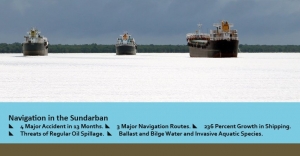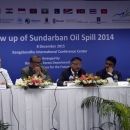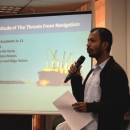Newsroom :: News :: Conservationists and experts urge for environmental management of navigation and reduction of pollution in the Sundarban waters
Conservationists and experts urge for environmental management of navigation and reduction of pollution in the Sundarban waters
Mangroves for the Future’s National Coordinating Body gathers government, civil society and academia to review progress made after the Sundarban oil spill 2014
Location: Dhaka, Bangladesh. 8th Dec 2015
The Sundarban oil spill in 9 December 2014, brought attention of national and international community due to the potential risks posed by it to the world’s largest mangrove forest, which is also a world heritage site and a wetland of international significance as designated under the Ramsar convention. It was the concerted efforts from the Government of Bangladesh, the United Nations, International Development Partners, NGOs, private sector and people living near the oil spill site in Joymoni village of Mongla that enabled removal of a large portion of the debris and the oil immediately after the accident.
Mangroves for the Future Bangladesh supported a small group of conservationist and biologists to observe the status of the oil spill affected areas in the navigation routes within the Sundarban. Observations from those trips were shared in this event.
Dr. Niamul Naser, Professor of Zoology in the University of Dhaka, indicated that, in some spots, microorganisms are coming back in a limited scale, which is a sign of natural healing, but a proper baseline of all life forms in the Sundarban needs to be set to be able to do a proper monitoring of the changes caused duet to anthropogenic stressors like navigation or industrial pollution in the waters, especially to understand the long term impacts on the ecosystem.
Mr. Mohammad Arju, the CEO of Save Our Sea, showed the trends of increased traffic and spatial extent of de-facto and de jure navigation routes of in country and international shipping through the Sundarban and recommended initiating monitoring of vessels by promoting Automatic Identification System (AIS), ensuring ship safety rules and establishing ballast water management system in collaboration with India.
Mr. Md Amir Hossain Chowdhury shared his experience as the officer in charge of the particular portion of the Sundarban which was affected by last year’s oil spill, especially the ways in which the Forest Department with help from the community people improvised local techniques to soak and remove the oil from the river to avoid mass spread. He also contended that there is a need for capacity development of the officials to manage such accidents and a permanent response mechanism needs to be established.
IUCN Bangladesh Country Representative Mr. Ishtiaq Uddin Ahmed called for setting up permanent ecological plots and do complete biodiversity auditing in regular interval to ensure safety and sustainability of the Sundarban ecosystem.
Md. Yunus Ali, the Chief Conservator of Forests, Bangladesh Forest Department while chairing the event, opined that ‘to keep the economic growth sustainable, knowledge based management is necessary and to environmentally manage navigation and other developments in the Sundarban region, a strong baseline needs to be set’.
UNDP Assistant Country Director Mr. Khurshid Alam echoed that the balance between economic growth and nature’s integrity is the key to achieve the Sustainable Development Goals. USAID Bangladesh’s Environmental Team Leader Mr Karl Wurster expressed the commitment to collaborate with the government of Bangladesh to keep safe Sundarban, a valued treasure of the nature, in light of the long history of cooperation between Bangladesh and the United States of America.
Lead personnel from the Ministry of Environment and Forests, Forest Department, members of the Mangroves for the Future’s National Coordinating Body and many of the volunteers and experts who worked during the cleanup work in 2014 and worked in the joint GoB-UN mission in response to the oil spill, also participated in the event.
The statistics from the Mongla Port Authority shows that navigation in the Sundarban waterways has increased 236 percent in last 7 years. Which means, vessel based regular pollutions may continue to add risks to the world’s largest mangrove habitat’s health even if accidents like Shella Oil Spill can be prevented. Increasing pattern of shipping and navigation volume necessarily indicates growing industrialization in the Sundarban Impact Zone and the Sundarban Ecologically Critical Area, which in turn will increase the land based source of pollution if not managed.
Participants stressed on finalizing the contingency plan for oil spill response and the standard operational guidelines, and declaring Ecologically Critical Area Rules to control pollution from industrialization near the Sundarban.



